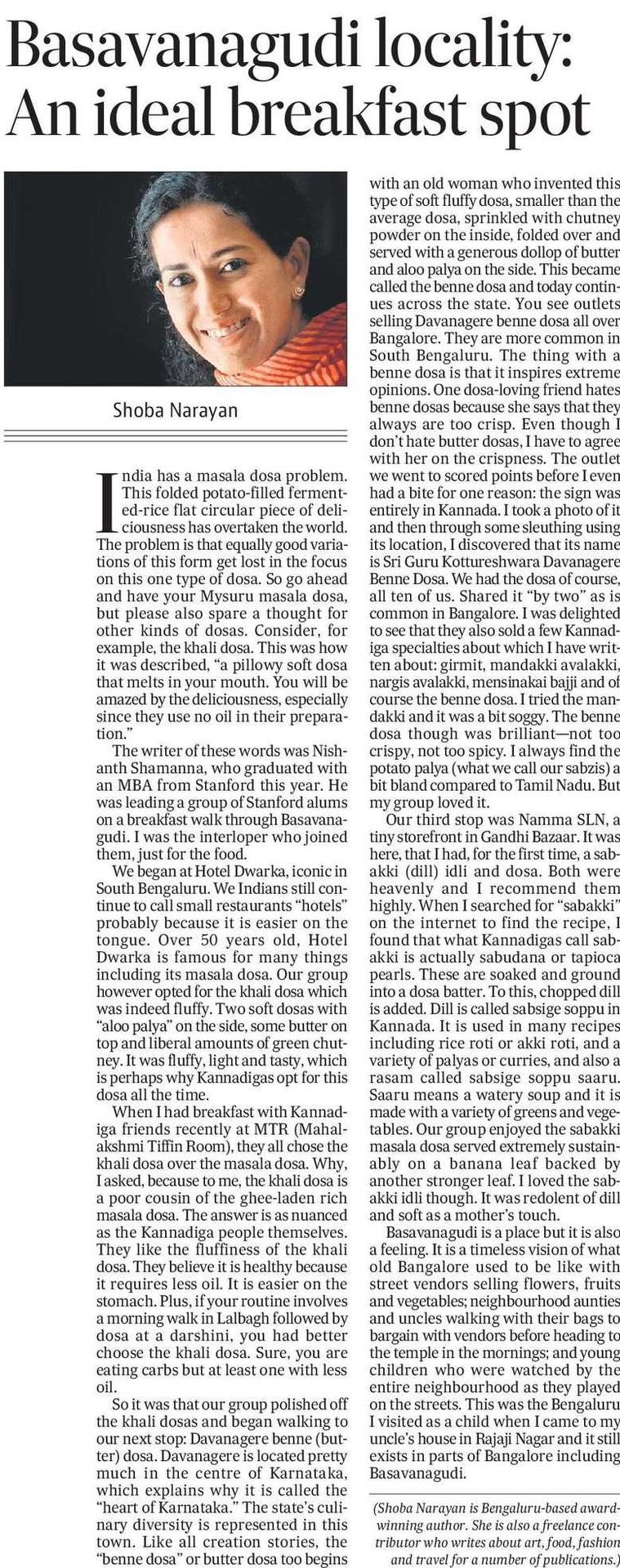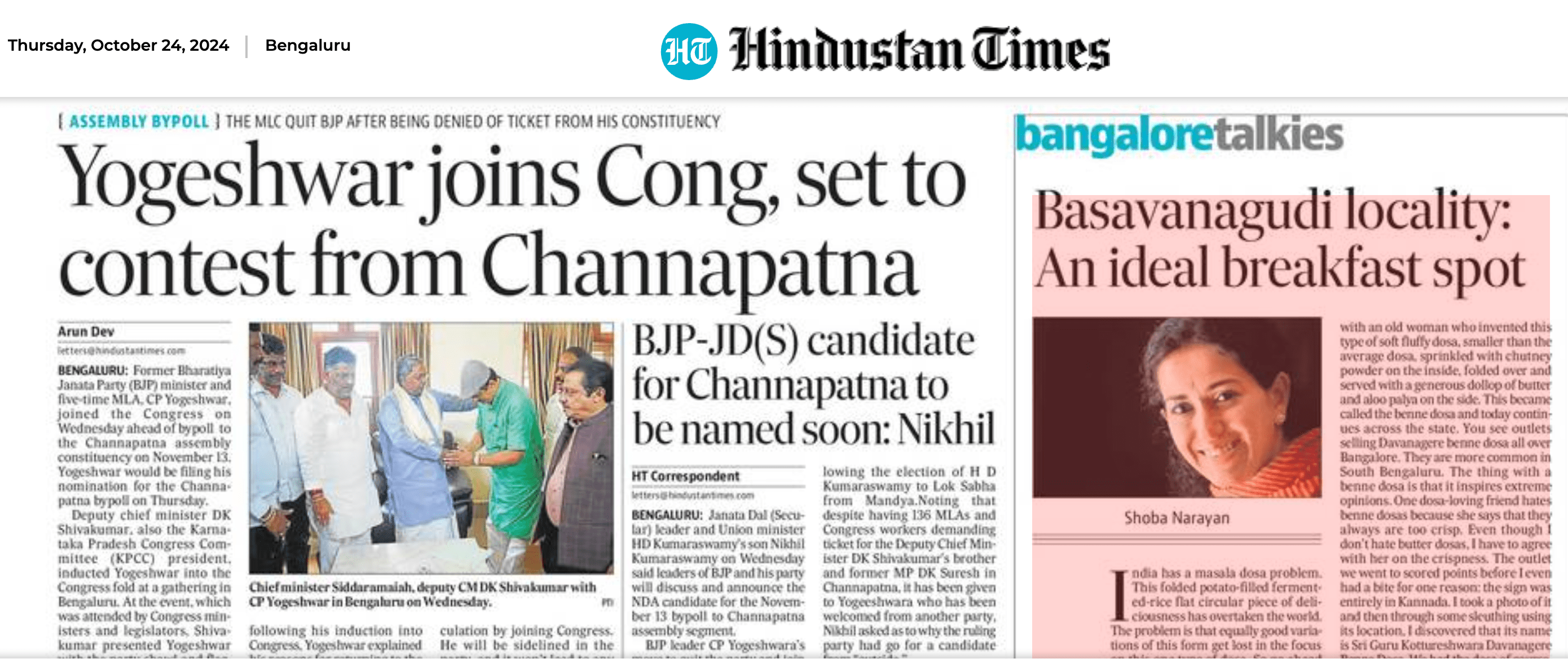India has a masala dosa problem. This folded potato-filled fermented-rice flat circular piece of deliciousness has overtaken the world. The problem is that equally good variations of this form get lost in the focus on this one type of dosa. So go ahead and have your Mysore masala dosa, but please also spare a thought for other kinds of dosas. Consider, for example, the khali dosa. This was how it was described, “a pillowy soft dosa that melts in your mouth. You will be amazed by the deliciousness, especially since they use no oil in their preparation.”
The writer of these words was Nishanth Shamanna, who graduated with an MBA from Stanford this year. He was leading a group of Stanford alums on a breakfast walk through Basavanagudi. I was the interloper who joined them, just for the food.
We began at Hotel Dwarka, iconic in South Bangalore. We Indians still continue to call small restaurants “hotels” probably because it is easier on the tongue. Over 50 years old, Hotel Dwarka is famous for many things including its masala dosa. Our group however opted for the khali dosa which was indeed fluffy. Two soft dosas with “aloo palya” on the side, some butter on top and liberal amounts of green chutney. It was fluffy, light and tasty, which is perhaps why Kannadigas opt for this dosa all the time. When I had breakfast with Kannadiga friends recently at MTR (Mahalakshmi Tiffin Room), they all chose the khali dosa over the masala dosa. Why, I asked, because to me, the khali dosa is a poor cousin of the ghee-laden rich masala dosa. The answer is as nuanced as the Kannadiga people themselves. They like the fluffiness of the khali dosa. They believe it is healthy because it requires less oil. It is easier on the stomach. Plus, if your routine involves a morning walk in Lalbagh followed by dosa at a darshini, you had better choose the khali dosa. Sure, you are eating carbs but at least one with less oil.
So it was that our group polished off the khali dosas and began walking to our next stop: Davanagere benne (butter) dosa. Davanagere is located pretty much in the centre of Karnataka, which explains why it is called the “heart of Karnataka.” The state’s culinary diversity is represented in this town. Like all creation stories, the “benne dosa” or butter dosa too begins with an old woman who invented this type of soft fluffy dosa, smaller than the average dosa, sprinkled with chutney powder on the inside, folded over and served with a generous dollop of butter and aloo palya on the side. This became called the benne dosa and today continues across the state. You see outlets selling Davanagere benne dosa all over Bangalore. They are more common in South Bangalore. The thing with a benne dosa is that it inspires extreme opinions. One dosa-loving friend hates benne dosas because she says that they always are too crisp. Even though I don’t hate butter dosas, I have to agree with her on the crispiness. The outlet we went to scored points before I even had a bite for one reason: the sign was entirely in Kannada. I took a photo of it and then through some sleuthing using its location, I discovered that its name is Sri Guru Kottureshwara Davanagere Benne Dosa. We had the dosa of course, all ten of us. Shared it “by two” as is common in Bangalore. I was delighted to see that they also sold a few Kannadiga specialties about which I have written about: girmit, mandakki avalakki, nargis avalakki, mensinakai bajji and of course the benne dosa. I tried the mandakki and it was a bit soggy. The benne dosa though was brilliant—not too crispy, not too spicy. I always find the potato palya (what we call our sabzis) a bit bland compared to Tamilnadu. But my group loved it.
Our third stop was Namma SLN, a tiny storefront in Gandhi Bazaar. It was here, that I had, for the first time, a sabakki (dill) idli and dosa. Both were heavenly and I recommend them highly. When I searched for “sabakki” on the internet to find the recipe, I found that what Kannadigas call sabakki is actually sabudana or tapioca pearls. These are soaked and ground into a dosa batter. To this, chopped dill is added. Dill is called sabsige soppu in Kannada. It is used in many recipes including rice roti or akki roti, and a variety of palyas or curries, and also a rasam called sabsige soppu saaru. Saaru means a watery soup and it is made with a variety of greens and vegetables. Our group enjoyed the sabakki masala dosa served extremely sustainably on a banana leaf backed by another stronger leaf. I loved the sabakki idli though. It was redolent of dill and soft as a mother’s touch.
Basavanagudi is a place but it is also a feeling. It is a timeless vision of what old Bangalore used to be like with street vendors selling flowers, fruits and vegetables; neighbourhood aunties and uncles walking with their bags to bargain with vendors before heading to the temple in the mornings; and young children who were watched by the entire neighbourhood as they played on the streets. This was the Bangalore I visited as a child when I came to my uncle’s house in Rajaji Nagar and it still exists in parts of Bangalore including Basavanagudi.
Shoba Narayan is Bangalore-based award-winning author. She is also a freelance contributor who writes about art, food, fashion and travel for a number of publications.



-k4lD-U204025897261YmH-250x250%40HT-Web.jpg)




Leave A Comment